Playing card
![]()
This article explains traditional, European playing cards. For Indian playing cards, see Playing card (Indian); for East Asian playing cards, see Playing card (East Asian). For card games with own hand, see Card game#Games with own hand.
![]()
Ace of hearts is a redirect to this article. For other meanings, see Ace of hearts.
Playing cards are usually rectangular, handy pieces of cardboard or stiff paper, or more rarely plastic, which show values and symbols on the front (obverse) and are blank or have a uniform motif on the back (reverse), so that the value of the card turned over is not recognizable. Each card is defined by two parameters: a value and a symbol called a suit. The card values are both numbers and figures such as the king; usually there are 13 values in total in hierarchical order. Card decks usually have four suit symbols, but their names and designs vary by culture. Thus, a full deck consists of 4 × 13 = 52 cards; however, many decks use only a portion, e.g., 4 × 8 = 32 cards. Shuffling a deck brings randomness into play, and the neutral backs of the cards keep information hidden, allowing for games with imperfect information. When they were introduced in Europe, playing cards were the first and only means of playing with these properties.
Modern playing cards usually feature their suit symbol and value in two opposite corners, or even in all four corners, so that the card can be identified even when the majority of the card is covered. The rest of the card face can be plain, but also offers room for artistic design. The motif on the front is often dot-symmetrical so that the cards can be read "upside down". Common card sizes in the Western world today are about 6 × 9 cm for a standard deck or 4.4 × 6.7 cm for a solitaire game.
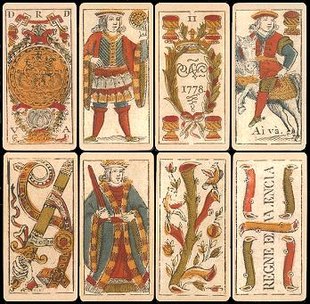
Spanish playing cards from 1778
Map Sheets
![]()
Map sheet is a redirect to this article. For the cartographic term, see Map (cartography) #Construction of a map.
In German-speaking countries and internationally, several different types of playing cards are in use. In Germany and Austria, for example, the Franconian, Altenburg, Bavarian and French hands are played, and in Austria the tarot hand is also used. In Switzerland, on the other hand, the French hand and the Swiss hand, known as the "German hand", are common. There is a cultural border that runs through the middle of the canton of Aargau: to the east of it the German leaf is common, to the west the French.
Meanwhile, aspects of gender equity, non-discrimination and diversity are sometimes incorporated into the design: What is a king in the common depiction is divided horizontally, showing a king on one side and a queen on the other. Various figures do not conform to any of the common ideals of beauty, wear headscarves or are non-binary. some boys are shown as People of Color.
French sheet
The French sheet has the color values:
| Cross | Spades | Heart | Check |
| Trèfle | Pique | Cœur | Carreau |
|
|
|
|
|
The card symbol of the suit cross is a shamrock. The original French name for it is trèfle "clover". Following this, the suit is called Treff in Austria, which can be traced back to 1776 in Strasbourg, Alsace. Possibly it was believed that the final syllable -le in the previously common Treffle was a diminutive form. More likely, however, the almost silent final syllable in fast speech was simply overheard. The suit Spades is colloquially called Schippe in the Rhineland, but Schaufel (Schuufle) in the German-speaking regions of Switzerland and in some regions of southern Germany. The suit Diamonds is called here Ecken (Egge).
The card values range from one (Ace, A) to ten and then continue with the court cards Jack or Page (B or V for fr. Valet "servant, servant"), Queen (D, fr. Dame, or Q for English Queen) and King (K or R for fr. Roi). This makes a total of 52 cards or hands. For some games (Rummy, Canasta) these are extended by one to three Jokers.
Packs of playing cards (hands) are available in stores in the following common combinations:
- Rummy - Bridge - Canasta: 2 × 52 hands + 6 jokers = 110 hands. In order to be able to quickly separate a single hand of 55 cards (52 hands + 3 Jokers), the backs of the two included hands of 55 cards each have different suits. Rarer are versions where all 110 cards have uniform backs. With this hand, all common card games that do not use cards specially designed for the game can be played. Cards that are not needed can be removed from the deck as needed.
- Patience: corresponds to Rummy - Bridge - Canasta with different colors of the two included hands of 55 cards. The cards are significantly smaller than usual playing cards with French hand to be able to lay patience even with limited space.
- Poker, Whist or Bridge: 52 hands. Occasionally, three jokers are included with the hand, which means that two of these hands can be combined to form a rummy - bridge - canasta hand.
- Baccarat 6× 52 sheets. The cards bear no index marks and have plain backs with no pattern.
- Skat: 32 hands, card values in order from bottom to top 7, 8, 9, Queen, King, 10, Ace, above the four Jacks Diamonds, Hearts, Spades, Clubs.
- Jass or Durak: 36 hands, card values 6...10, Jack, Queen, King, Ace.
- Doppelkopf: 2 × 24 hands = 48 hands, card values 9, 10, Jack, Queen, King, Ace, where each card is doubled. Occasionally the hand is accompanied by a joker.
- Tarot: 78 sheets, 56 false suits with card values 1...10, jack, rider, queen, king, plus 21 trumps I...XXI and an excuse. The Tarot sheet is the complete French card sheet and is used in more artfully designed variants (e.g. with Italian picture) for card laying.
Higher-value hands are sealed in a transparent film in their original packaging. This circumstance is often used by card players to indicate to the other players that the game is being played with a new, non-inked hand. The cover sheet is an additional card, in the case of the Rummy-Bridge-Canasta hand one card per 55-card hand, on which a court card, in the case of the Skat hand usually the Jack of Clubs, is usually depicted on one half side and on the other half side details about the hand (manufacturer, type of hand and image used, number of cards included without the cover sheet) are printed. If the cover sheet has the same back as the other cards of the hand, it can be used in the game, usually with the application of special rules. In the case of the Skat hand, the cover sheet alternatively also contains a short form of the Skat rules.
· 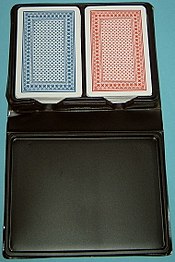
Different colored backs in the Rummy Bridge Canasta hand
· 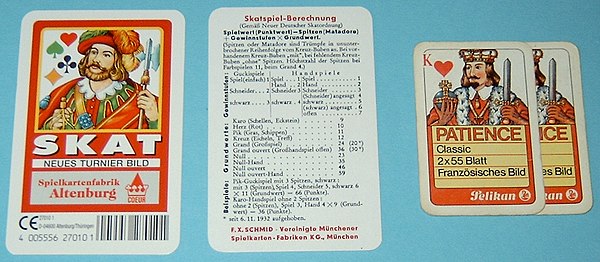
Cover sheets: left and middle for a skat hand, right for the solitaire hand
· 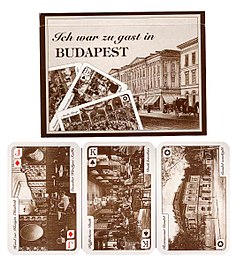
Hungarian playing cards with decorative motifs
In Switzerland and North America you can also find a - less common - variant of the French hand, in which the four symbols (suits) are all coloured differently: The cards of clubs are olive green (instead of black) and the cards of diamonds are in light blue or orange (instead of red). These playing card suits are also handy in poker, as it prevents the diamonds and hearts or spades and clubs from being confused, which can be very awkward, especially with a supposed flush. These so-called four-colour decks (as opposed to two-colour decks) have not become widely accepted when playing with real playing cards, but are very common in online poker, at least as an option, since poor image resolution (for example, due to playing at several tables at the same time) or overtiredness make it exhausting to distinguish the exact playing card colours. In addition, it is technically possible without any problems for some players at one table to see the cards as a popular two-colour deck and other players at the same table to see the same cards as a practical four-colour deck.
Symbolism of the court cards
The court cards Jack (pawn), Queen and King represent different historical or mythological persons:
- Cross King: Alexander the Great
- King of spades: David
- King of Hearts: Charlemagne
- King of Diamonds: Julius Caesar
- Lady of the Cross: Juno Regina (Roman chief goddess and wife of Jupiter as well as patroness of marriage)
- Queen of spades: Pallas Athene (Greek goddess of wisdom)
- Queen of Hearts: Judith (biblical ideal of piety)
- Queen of Diamonds: Rachel (biblical figure as ideal of beauty)
- Jack of clubs: Lancelot, the knight from Arthurian legend
- Jack of spades: Hogier (Holger Danske), a cousin of Charlemagne
- Jack of Hearts: La Hire (Étienne de Vignolles), a soldier at Joan of Arc's side.
- Jack of Diamonds: Hector of Troy or Roland, a paladin of Charlemagne
Anglo-American paper
The Anglo-American hand corresponds to the French hand in terms of suits and card values, but in design the pictures and the ace of spades, which is usually a decorative picture, differ from the French hand. In addition, the Queens bear the letter "Q" for Queen instead of "D" and the Jacks the letter "J" for Jack instead of "B".
The Anglo-American playing cards were the first with index designations (indication of suit and value in the corners), which are now common for all hands with French suits, with a few exceptions (Baccarat, Écarté, Préférence and Schnapsen).
A special form of the Anglo-American hand are poker cards (for the differences see the section Differences to the Anglo-American hand).
German paper
| AcornCornerCone Cross | FoliageGreenGrassSpadeLeafScrapersBlue | HeartRed | ClampsCheckBolls |
|
|
|
|
|
The German leaf knows the colors acorn, foliage, heart and bell. The names for the different suits show partly clear regional differences (alternative names see graphic). In addition to the cards with numerical values, there are the four face values Unter (also Bauer), Ober (also Dame), König, and Daus or Sau (possibly due to the pig on the Schell-Daus on the sheets of the Salzburger or einfachdeutsches Bild and the Bayerisches Bild). In most variants in use today, the card values range from 6 to 10, as well as Under, Upper, King, and Ace. Around 1500, all four deuces in the Ulm-Münchner picture each featured a pig. The Deuce is often played as an Ace. The name Daus is derived from French deux or Latin duo: The Daus was originally the two and not the one; in the Salzburger or Einfachdeutsch and in the Swiss Blatt this still survives in the representation. In Swabian the Daus is also often called the "Alte". The cards with the value 6 are only used in a few games. In some games the Weli is added as a Joker. The Ober is probably derived from the knight of the Tarot hand.
The German sheet is divided into many regional versions, which differ in the details of the suit symbols and especially in the drawings of the court cards and the sow. There are, for example, Old German, Swiss German, Bavarian, Franconian, Saxon, Salzburg or Baden sheets. The Württemberg sheet follows the theme of the German sheets, orientates itself with the kings on the French sheet and assigns them the same attributes (sceptre, apple, harp).
Many popular card games use a further reduced hand, whereby the small number cards (in the jargon of the card players called Luschen, Schwanzal or Spatzen) are omitted. In extreme cases, this means that only the card values 9, 10, Under, Upper, King and Ace remain in the short Schafkopf, and in the very short one the nines are also dropped, similar to Schnapsen, reducing the hand to 20 cards. Also the order of the cards can be very different. Other games double a possibly reduced hand. For example, Doppelkopf is played with two short Schafkopf hands, i.e. 2 × 24 hands = 48 hands.
The color assignment between the German and French sheets is as follows:
| German paper | Acorn | Foliage | Heart | Clamps |
| French sheet | Cross | Spades | Heart | Check |
Various cards also have their own names, so the King of Hearts is also called "Max", possibly as an allusion to the Bavarian King Maximilian. In Thuringia and Saxony the Acorn Under (Jack of Clubs) is often called "Alter".
Hungarian/Central European/Double German Sheet
In Austria, Hungary, Slovakia, Slovenia, Croatia, parts of Bosnia and parts of the Czech Republic a sheet is in use which uses the same colours as the Bavarian sheet and is illustrated with personalities from the Wilhelm Tell saga (see picture).
The Tell map was created at the time of the Hungarian uprisings against the Habsburgs: in order to circumvent the censorship, which would have prevented the illustration with leaders of the uprising, one fell back on the Wilhelm Tell saga, which is also about an uprising against the Habsburgs. Friedrich Schiller's play Wilhelm Tell had been performed in 1827 in the Transylvanian town of Klausenburg (Hungarian: Kolozsvár, Romanian: Cluj-Napoca). In 1974, the oldest of these maps was discovered in an English private collection, on which the dates were also found: "To be found with Joseph Schneider in Pesth." In Austria, this sheet is known as doppeldeutsch - in contrast to the Salzburg or single German sheet. Interestingly, despite the illustrations with personalities from Swiss history, this sheet is almost unknown in Switzerland.
Unter, Ober and Daus of each color each show a particular person (Unter, Ober) from Friedrich Schiller's Tell drama or a season (Daus). These are:
- Heart
- Under: Werner Stauffacher or Kuoni, the Shepherd
- Waiter: Hermann Gessler
- Daus: Spring, a young woman picking flowers
- Clamps
- Under: Arnold von Melchtal or Itel Reding
- Waiter: Stüssi, the field protector
- Daus: Summer, a young woman mowing hay with a sickle...
- Green
- Under: Walter Fürst
- Waiter: Ulrich von Rudenz
- Daus: Autumn, two boys processing grapes
- Acorn
- Under: Rudolf the Harras
- Waiter: William Tell
- Daus: Winter, an old woman carrying firewood
Since the game of sixty-six or Schnapsen is played partly with French and partly with German cards, German-French cards are used in tournaments. These cards are divided in the middle and show the German picture in one half and the corresponding French picture in the other half, e.g. Schell-Ober and Queen of Diamonds.
In Bavarian Schafkopf the individual cards have special designations, for example the old man for the acorn top, the blue for the leaf top, the fox for the heart top, the old woman, the blue and the bump for acorn, leaf and shell ace, the latter also called sow. Further, green, grass, or foliage for leaf.
Altenburger Blatt
The Altenburg hand distributed by ASS Altenburger is a slightly modified German hand, which originated from the Saxon pattern. It consists of exactly 32 cards for use in Skat. The card values range from 7 to 10, as well as Under, Upper, King and Ace. The suit values are identical to the German Hand, their design differs slightly (e.g. in Acorn the acorn is coloured red, slightly longer and more angular, Green or Leaf looks green, Bell mark is more ornate). A variant with ladies instead of the uppers is also offered. The bottoms of this variant bear the corner mark B for Jack.
The Altenburger Blatt was designed in the 1960s by the Rodewisch-born graphic artist Walter Krauß (1908-1985) for the Volkseigener Betrieb Altenburger Spielkartenfabrik and distributed in the GDR as the Neue Altenburger Spielkarte. Today it is traditionally played in Central Germany, i.e. roughly within the borders of Saxony, Saxony-Anhalt and Thuringia.
Bavarian paper
The Bavarian picture develops from about 1650 in different types. In all variants the Upper and Lower fight, being accompanied by the Grass Upper and Lower with drum and whistle respectively. Bavarian cards have approximately an aspect ratio of 2:1, which was used in the earlier single-picture, especially on the numeral cards, for various pictorial representations. The only pictorial representations are found only on the deuces (deuces, sows, or erroneously aces).
Variants still in use today are:
- Bavarian-Swabian picture
- Bavarian double image, Munich type
- Bavarian double image, Stralsund type
- Single images of the double images common today
- Franconian double image
- Bohemian picture
- Salzburg picture (also simple German picture)
Variants no longer in use today are:
- Old Bavarian image (common predecessor) with variants in Poland and Russia
- Isar circle picture (precursor of the Salzburg picture)
- Nuremberg Eagle (Coat of Arms)-Map
- Regensburg picture (precursor of the Bohemian picture)
- Tyrolean picture
The Augsburg Picture
The original type of today's Bavarian sheet is the Augsburg picture around 1500, in addition to the Ulm-Munich picture. The four kings seated on thrones are each accompanied by two arms-wielding servants. Upper and lower of the colour grass are military musicians, the upper is a bagpipe-playing jester, the lower plays a fanfare or flute. The Upper and Lower of Hearts fight with polearms, the Upper and Lower of Bells with a sword, and the Upper and Lower of Acorns with a mace and hunchback shield.
The Old Bavarian Picture
From the middle of the 17th century, after the Thirty Years' War, the Augsburg image changes to the so-called Old Bavarian image. Eichel-Ober and -Unter now fight with rapier and parrying dagger. Gras-Ober and -Unter now play with drum and whistle; drummer and whistler become from now on the distinctive mark of the Bavarian picture. Upper and lower of the same color fight each other, as in a fencing school, with equal weapons. In this period the number of cards is also reduced, probably due to a lack of paper, from the previous 48 (the One - Ace - had already disappeared before) to 36 hands (Three, Four and Five disappear, Two - Deuces - was already of higher value than the King at that time). At the end of the 17th century, during the Turkish Wars, the King of Grass and the King of Acorn exchange their crowns for turbans. The deuce cards show a pyramid of unicorn, stag and eagle on the grass deuce, Bacchus on the acorn deuce, a wild boar with hunting dog on bell deuce and usually a Cupid on heart deuce. Around 1750, this image was widespread throughout the region populated by Bavarians. Smaller variants of this picture were widespread in Congress Poland until 1918.
The modern Bavarian picture
In the newly created Kingdom of Bavaria, the Old Bavarian image changes after 1810 to the modern Bavarian image. A vase now appears on the Gras-Daus, the Eichel-König receives a crown again - the only "Oriental" now remains the Gras-König. The Upper of Hearts exchanges his pole weapon for a sword, which he leans on. The upper and lower acorns each receive only one weapon, the upper acorn additionally an oval shield. This type, created by the Munich card maker Josef Fetscher, is known today as the Munich type of the Bavarian Pattern in the drawing by the Frankfurt card maker "C. L. Wüst", which was made around 1854, and was widely distributed by the playing-card factory "F. X. Schmid".
From 1882 onwards, the Vereinigte "Altenburger und Stralsunder Spielkarten-Fabriken" print their own version of the Bavarian pattern, which goes back to a card pattern by the Frankfurt card factory "Lennhoff & Heuser". The Kings, Upper and Lower are dressed in fantasy uniforms in the style of Historicism. Essential distinguishing features of this Stralsund type of Bavarian image from the Munich type are:
- The grass-upper wears his drum on his right knee instead of his left.
- The Eichel-Unter receives a beret.
- The acorn top has a pointed shield instead of an oval one.
- The Bacchus on the acorn deuce has a beer stein instead of a wine stein.
- Cupid has butterfly wings.
In the 20th century, the number and figure cards were gradually given index signs, and finally the "A" was mistakenly used on the Dausen instead of the correct "D". After the Second World War, the single face that had dominated until then finally disappeared and was replaced by the double face that is still widespread today.
Frankish paper
The Franconian hand consists of 36 cards: Acorn, Green, Heart, and Shell each as Ace, King, Upper, Lower, 10, 9, 8, 7, and 6. It differs in design from the Bavarian hand. It originated after 1840 from the Munich type of the Bavarian pattern.
The Ace of Bell and Ace of Hearts are relatively plain in design, the Ace of Green shows an eagle and the Ace of Acorn shows a lion.
French sheet with German colors
| Cross | Spades | Heart | Check |
|
|
|
|
|
The French hand with German colours is the official tournament hand of the International Skat Rules for Skat. It is a hand that uses French symbolism, where the colours of the symbols are not black and red, but black, green, red and yellow (four-colour hand).
This variant came into being after the reunification of Germany, since in West Germany and in the north of East Germany the French hand was in use, in the south of East Germany the Altenburg hand. In order to unite both players' associations, this compromise was agreed upon at the 25th Skat Congress in 1990.
Swiss newspaper
| Acorns | Schilten | Roses | Clamps |
|
|
|
|
|
East of the Brünig-Napf-Reuss line, the Swiss national game of Jass makes use of a variant of the German cards with 36 cards, the so-called Swiss-German cards. They consist of the suits acorns, shields, roses and bells. The values are sixes through nines, banner, under, upper, king and ace (also sow or deuce). The shields correspond to the suit green, the roses to the hearts; the four banners to the tens.
West of the Brünig-Napf-Reuss line and in Graubünden Jass is played with French cards (36 cards per pack: 6 to 10 each, Jack (as trump suit: pawn), Queen, King, Ace); Diamonds are called "corners", Spades "shovels". In the Jass broadcasts of Swiss television French cards are used in four (instead of two) suits: Clubs in green (instead of black) and Corners (Diamonds) in blue (instead of red), Hearts as usual in red and Shovels (Spades) in black. These cards are also sold in department stores and should make it easier for beginners to tell the suits apart.
The color assignment between the Swiss and French sheets is common in the following form:
| Swiss newspaper | Acorns | Schilten | Roses | Clamps |
| French sheet | Cross | Shovels | Heart | Corners |
Tarot sheet
The Tarot hand in use today has the same suits as the French hand: hearts, diamonds, spades and clubs. The card values used are: 7 to 10, Jack/Page, Knight/Rider, Queen, King. In some variants, the values 4, 3, 2 and 1 are also used as number cards in the red suits of hearts and diamonds. In addition there are the "Tarock", which are court cards consecutively numbered from I(Pagat) to XXI (Moon, incorrectly for fr. le monde, the world) and the Sküs(s). Altogether this makes a hand of 54 cards. In most variants of the game Tarock these cards have the function of the trump suit; the Sküs(s) also trumps all other Tarock.
There are also many regional versions of the tarot sheet, which differ in the design of the court cards and the illustrations on the tarot cards.
Italian-Spanish leaf
The Italian-Spanish sheet has the colors
| italianspanishgermancroatian | SpadeEspadasSwordsŠpade | CoppeCopasCupsCupe | DenariOrosCoinsDinari | BastoniBastosSticksBaštoni |
| Color sarde |
|
|
|
|
| Colour siciliane |
|
|
|
|
| Color napoletane |
|
|
|
|
| colour romagnole |
|
|
|
|
| Color piacentine |
|
|
|
|
| Colour bolognesi |
|
|
|
|
| Colour trevisane |
|
|
|
|
| Colour triestine |
|
|
|
|
| Colour trentine |
|
|
|
|
| Color bresciane |
|
|
|
|
| Color bergamasche |
|
|
|
|
The sub-groups differ as follows: In the Italian variant, the staffs are represented as scepters and the number cards show crooked swords. In the Spanish variant, the staffs are represented as clubs and the number cards show straight swords.
The card values range from Asso/Ass (one) to Seven or to Nine and then continue with the court cards Fante/Sota (Jack, Soldier), Cavallo/Caballo (Rider) and Re/Rey (King). Although the court cards start with the number ten, the cards eight to nine are hardly used, so that there are packs of 40 instead of 48 hands.
A variant of the Italian-Spanish card is the Trappolier card (after the card game Trappola), this was especially common in Silesia, so that they are also called Silesian playing cards. The king is called "the deer" after the Italian Re; the number cards are ace, deuce, seven, eight, nine and ten, so a total of 36 hands.
The assignment of the Italian-Spanish to the French colors is as follows:
- Spade, Espadas - Spades
- Coppe, Copas - Heart
- Denari, Oros, Ouro (Portuguese) - Diamonds
- Bastoni, Bastos, Palo, Paus (Portuguese) - Cross or Hit
The suits of the Italian-Spanish hand are also found on the Tarot cards used for divination. (The French Tarot or Austrian-German Tarot playing cards use the suits of the French hand).
Other playing cards
In addition to the traditional cards, there are also other motifs of the classic and numerous card games with their own hand.
In addition, there are also so-called divination, oracle or fortune-telling cards, which are used for the purpose of predicting the future. These can be specially made for this purpose cards, or even an ordinary Skat hand. In Japan there are the traditional Hanafuda and Kurofuda.

Kurofuda
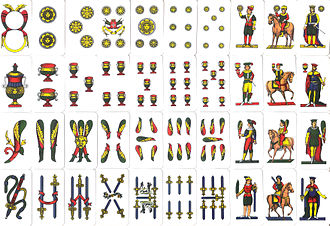
Napoletane
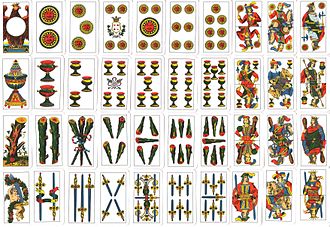
Piacentine

Extended German-Swiss sheet for the Kaiserspiel

Skat sheet, french picture with german colors
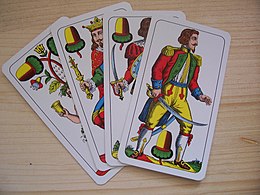
Single German (Salzburg) Jass cards

Cover sheet of the Altenburg leaf with acorn underneath
.jpg)
A double german hand, croatian picture, with 32 cards

A double German hand with 36 cards (in Hungary 32 cards from VII)
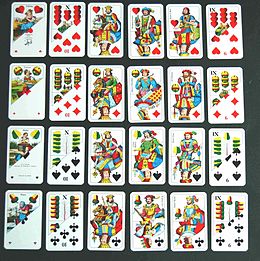
German-French liquor cards
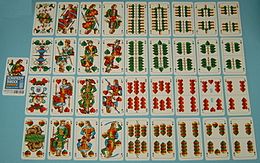
Schafkopf tarock sheet, bavarian picture
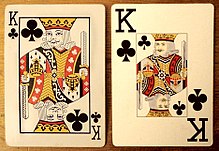
Normal and large index cards (f. l. t. r.)

Anglo-American paper
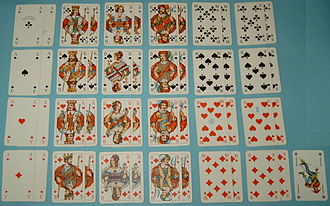
Double-headed hand (with Joker), French picture with German abbreviations on the court cards

Rummy Bridge Canasta hand, French picture with German abbreviations on the court cards
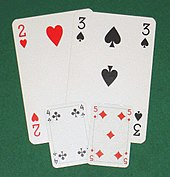
Smaller solitaire cards compared to normal playing cards

Use and distribution of French and German map sheets in Germany, Switzerland, Liechtenstein, Austria and South Tyrol
Playing Card Tax
In various countries, playing cards became taxable soon after their introduction and were therefore stamped by the sovereign who collected the tax or his agents. In France, for example, this tax was levied since 1583. The playing-card maker printed a small white circle on the front of a specified card, on which the tax official then placed his stamp. After that, the cards were allowed to be sold. The tax was a significant portion of the selling price. In Germany, the collection of playing-card taxes was the responsibility of the states until 1879. On January 1, 1879, uniform tax rates came into force throughout the Reich. For decks of up to 36 cards a tax of 30 Pfennig was levied, for decks with more cards 60 Pfennig. On November 1, 1919, the tax rates were increased significantly. They were now one mark for hands up to 24 cards, two marks for hands up to 48 cards, and three marks for larger hands. The German inflation of 1914 to 1923 also led to an increase in the tax on playing-cards. At its peak, the tax rate was 26 million Marks per hand. Accordingly, the stamps were now applied without indicating the value. After the inflation period, the tax rate returned to 30 Pfennig. On August 1, 1939, this petty tax was abolished.

stamp playing-card tax German Reich 1879 to 1889, 30 Pfennig
Questions and Answers
Q: What is a playing card?
A: A playing card is a card used in various card games like poker, blackjack, and solitaire, among others.
Q: How many cards are there in a standard deck of playing cards?
A: There are 52 basic cards in a deck, not including the jokers.
Q: What information does a playing card contain?
A: A playing card contains a suit and a number, also known as the value or rank.
Q: How many suits are in a deck of playing cards?
A: There are four suits in a deck of playing cards.
Q: How many ranks are there in each suit of playing cards?
A: There are 13 ranks in each suit of playing cards.
Q: Are there regional or national patterns in decks of playing cards?
A: Yes, decks of playing cards may include a wide variety of regional and national patterns, as well as different deck sizes.
Q: What is the English pattern of playing cards also known as?
A: The English pattern of playing cards is often also known as the International or Anglo-American pattern.
Search within the encyclopedia










